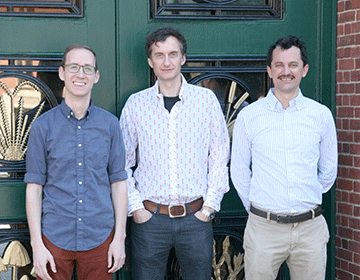(l to r) Jeff Farrell, Alex Schier, and Julien Dubrulle
While most cells in the body have the same DNA, and thus the same set of genes, cells are highly specialized because they express different subsets of those genes. For example, the expression of one set of genes instructs liver cells to build the proteins needed to detoxify blood, while heart cells express a different set of genes that enables them to contract. These differences in gene expression are established during embryogenesis, when signals instruct cells to acquire their distinct specializations. To understand embryogenesis, one needs to know which cells express which genes and how signals can cause different cells to express different sets of genes. Two recent publications from the Schier lab address these questions.
Jeff Farrell in the Schier lab and Rahul Satija and Dave Gennert in the lab of Aviv Regev (Broad Institute) developed a method to identify the expression patterns of genes during early embryogenesis (Nature Biotechnology 2015). They isolated hundreds of cells from a zebrafish embryo and sequenced the mRNAs of each cell. This approach told them which genes are expressed in different cells, but because the cells had been removed from the embryo, it was unclear where each cell was originally located. To solve this problem, they built an atlas that used the previously mapped expression patterns of a few genes as “landmarks.”. By comparing each cell’s expression of those landmark genes to the atlas, they computationally reconstructed where each cell came from. This approach allowed them to reconstruct the expression patterns of thousands of genes and define different cell types in the embryo. This strategy can now be applied to other animals and tissues to determine which cells express which genes and find out how genetic or environmental perturbations change gene expression.
Julien Dubrulle in the Schier lab, with Ben Jordan, Laila Akhmetova, Jeff Farrell, as well as Seok-Hyung Kim and Lila Solnica-Kezel (Washington University in Saint Louis), developed a new model of how gene expression is regulated during embryogenesis (eLIFE 2015). They asked how graded signals (so-called morphogens) could activate some genes in cells close to the source of the signal and other genes in cells farther away from the source. They found that, in contradiction to popular models, the amount of signal on its own is insufficient to predict whether a gene will be expressed in a given cell. Instead, a gene’s response depends on its rate of transcription and how rapidly it responds to the signal. This model provides insight into how cells are instructed to specialize during early development and inspires further biochemical and biophysical measurements
Read more in Nature Biotechnology or download PDF


